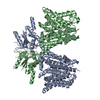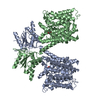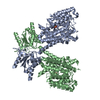[English] 日本語
 Yorodumi
Yorodumi- PDB-8tny: Substrate Binding Plasticity Revealed by Cryo-EM Structures of SLC26A2 -
+ Open data
Open data
- Basic information
Basic information
| Entry | Database: PDB / ID: 8tny | ||||||||||||
|---|---|---|---|---|---|---|---|---|---|---|---|---|---|
| Title | Substrate Binding Plasticity Revealed by Cryo-EM Structures of SLC26A2 | ||||||||||||
 Components Components | Sulfate transporter | ||||||||||||
 Keywords Keywords | MEMBRANE PROTEIN / human solute carrier / SLC26A2 / sulfate transporter | ||||||||||||
| Function / homology |  Function and homology information Function and homology informationDefective SLC26A2 causes chondrodysplasias / sulfate transmembrane transport / Multifunctional anion exchangers / Transport and synthesis of PAPS / : / sulfate transmembrane transporter activity / chondrocyte proliferation / oxalate transmembrane transporter activity / secondary active sulfate transmembrane transporter activity / solute:inorganic anion antiporter activity ...Defective SLC26A2 causes chondrodysplasias / sulfate transmembrane transport / Multifunctional anion exchangers / Transport and synthesis of PAPS / : / sulfate transmembrane transporter activity / chondrocyte proliferation / oxalate transmembrane transporter activity / secondary active sulfate transmembrane transporter activity / solute:inorganic anion antiporter activity / bicarbonate transmembrane transporter activity / chloride transmembrane transporter activity / microvillus membrane / chondrocyte differentiation / ossification / apical plasma membrane / extracellular exosome / membrane / plasma membrane Similarity search - Function | ||||||||||||
| Biological species |  Homo sapiens (human) Homo sapiens (human) | ||||||||||||
| Method | ELECTRON MICROSCOPY / single particle reconstruction / cryo EM / Resolution: 3.55 Å | ||||||||||||
 Authors Authors | Hu, W. / Song, A. | ||||||||||||
| Funding support |  United States, 3items United States, 3items
| ||||||||||||
 Citation Citation |  Journal: Nat Commun / Year: 2024 Journal: Nat Commun / Year: 2024Title: Substrate binding plasticity revealed by Cryo-EM structures of SLC26A2. Authors: Wenxin Hu / Alex Song / Hongjin Zheng Abstract: SLC26A2 is a vital solute carrier responsible for transporting essential nutritional ions, including sulfate, within the human body. Pathogenic mutations within SLC26A2 give rise to a spectrum of ...SLC26A2 is a vital solute carrier responsible for transporting essential nutritional ions, including sulfate, within the human body. Pathogenic mutations within SLC26A2 give rise to a spectrum of human diseases, ranging from lethal to mild symptoms. The molecular details regarding the versatile substrate-transporter interactions and the impact of pathogenic mutations on SLC26A2 transporter function remain unclear. Here, using cryo-electron microscopy, we determine three high-resolution structures of SLC26A2 in complexes with different substrates. These structures unveil valuable insights, including the distinct features of the homodimer assembly, the dynamic nature of substrate binding, and the potential ramifications of pathogenic mutations. This structural-functional information regarding SLC26A2 will advance our understanding of cellular sulfate transport mechanisms and provide foundations for future therapeutic development against various human diseases. | ||||||||||||
| History |
|
- Structure visualization
Structure visualization
| Structure viewer | Molecule:  Molmil Molmil Jmol/JSmol Jmol/JSmol |
|---|
- Downloads & links
Downloads & links
- Download
Download
| PDBx/mmCIF format |  8tny.cif.gz 8tny.cif.gz | 190.7 KB | Display |  PDBx/mmCIF format PDBx/mmCIF format |
|---|---|---|---|---|
| PDB format |  pdb8tny.ent.gz pdb8tny.ent.gz | 147.4 KB | Display |  PDB format PDB format |
| PDBx/mmJSON format |  8tny.json.gz 8tny.json.gz | Tree view |  PDBx/mmJSON format PDBx/mmJSON format | |
| Others |  Other downloads Other downloads |
-Validation report
| Arichive directory |  https://data.pdbj.org/pub/pdb/validation_reports/tn/8tny https://data.pdbj.org/pub/pdb/validation_reports/tn/8tny ftp://data.pdbj.org/pub/pdb/validation_reports/tn/8tny ftp://data.pdbj.org/pub/pdb/validation_reports/tn/8tny | HTTPS FTP |
|---|
-Related structure data
| Related structure data |  41429MC  8tnwC  8tnxC M: map data used to model this data C: citing same article ( |
|---|---|
| Similar structure data | Similarity search - Function & homology  F&H Search F&H Search |
- Links
Links
- Assembly
Assembly
| Deposited unit | 
|
|---|---|
| 1 |
|
- Components
Components
| #1: Protein | Mass: 74410.359 Da / Num. of mol.: 2 Source method: isolated from a genetically manipulated source Source: (gene. exp.)  Homo sapiens (human) / Gene: SLC26A2, DTD, DTDST / Production host: Homo sapiens (human) / Gene: SLC26A2, DTD, DTDST / Production host:  #2: Chemical | Has ligand of interest | Y | |
|---|
-Experimental details
-Experiment
| Experiment | Method: ELECTRON MICROSCOPY |
|---|---|
| EM experiment | Aggregation state: PARTICLE / 3D reconstruction method: single particle reconstruction |
- Sample preparation
Sample preparation
| Component | Name: SLC26A2 with sulfate / Type: COMPLEX / Entity ID: #1 / Source: RECOMBINANT |
|---|---|
| Source (natural) | Organism:  Homo sapiens (human) Homo sapiens (human) |
| Source (recombinant) | Organism:  |
| Buffer solution | pH: 7.4 |
| Specimen | Embedding applied: NO / Shadowing applied: NO / Staining applied: NO / Vitrification applied: YES |
| Vitrification | Cryogen name: ETHANE |
- Electron microscopy imaging
Electron microscopy imaging
| Experimental equipment |  Model: Titan Krios / Image courtesy: FEI Company |
|---|---|
| Microscopy | Model: FEI TITAN KRIOS |
| Electron gun | Electron source:  FIELD EMISSION GUN / Accelerating voltage: 300 kV / Illumination mode: FLOOD BEAM FIELD EMISSION GUN / Accelerating voltage: 300 kV / Illumination mode: FLOOD BEAM |
| Electron lens | Mode: BRIGHT FIELD / Nominal defocus max: 2500 nm / Nominal defocus min: 1000 nm |
| Image recording | Electron dose: 60 e/Å2 / Film or detector model: GATAN K3 BIOQUANTUM (6k x 4k) |
- Processing
Processing
| CTF correction | Type: NONE |
|---|---|
| 3D reconstruction | Resolution: 3.55 Å / Resolution method: FSC 0.143 CUT-OFF / Num. of particles: 141916 / Symmetry type: POINT |
 Movie
Movie Controller
Controller




 PDBj
PDBj



